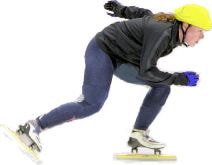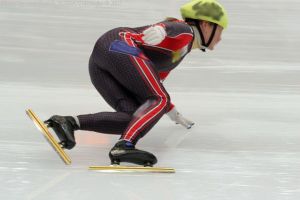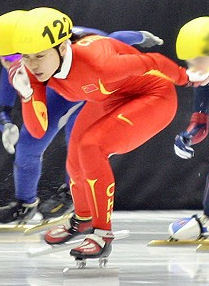Upper Body / Chest Position
By Susan Ellis, November 2004
Revised January 2012
Revised January 2012

Just as there is an ideal knee angle for each skater, there is an ideal position for the upper body. It is dependent on body type, torso vs leg length, flexibility, long track vs short track.
The goal is to bring your upper body in to a position that allows your weight to easily move forward along the blade from the heel to the ball of the foot. If it’s too high your weight will stay towards the back of the blade, especially on the corners, and if it’s too low your weight will come to the toe and it will be impossible to bring your hips under you. In general you want your sternum facing the ice but with your hips tucked under you.
The goal is to bring your upper body in to a position that allows your weight to easily move forward along the blade from the heel to the ball of the foot. If it’s too high your weight will stay towards the back of the blade, especially on the corners, and if it’s too low your weight will come to the toe and it will be impossible to bring your hips under you. In general you want your sternum facing the ice but with your hips tucked under you.
 Sternum too far ahead of shoulders and scoop back instead of round
Sternum too far ahead of shoulders and scoop back instead of round
Barrel-chested people often have problems getting the shoulders rounded and relaxed and their sternum ahead of shoulders forces the chest to be even higher. (photo to right)
Also skaters with very short torsos will usually have trouble rounding the back. Rounding the back is actually done through the belly muscles but if there is a very short distance between the top of the hip and the bottom rib, it's hard to comfortably round off.
Also skaters with very short torsos will usually have trouble rounding the back. Rounding the back is actually done through the belly muscles but if there is a very short distance between the top of the hip and the bottom rib, it's hard to comfortably round off.

When bringing the upper body in to position, suck in the abdominal muscles slightly to engage the abs and bring the hips slightly under you and bend over from the belly button. Bending from the hips rather than the belly button may leave your back flat and butt untucked and you won’t be able to fully use your abdominal, hip, and upper quad muscles. You should not be trying to round the entire back like a mad cat as this will pre-stretch muscles around the lower back and glutes needed for pushing and cause tension in the back. Although the upper body should be rounded, the key is to be relaxed.
To find your ideal chest position, bend your ankles, tuck your butt, round your shoulders, and slowly fold over your belly button to bring your chest lower. Stop when you feel the pressure under your foot at the back part of the ball of the foot. That is your ideal chest position.
Play with raising and lowering it and you will quickly find that even an inch too high or an inch too low has a great impact on where your weight is under your foot. If it is too high your weight goes back toward your heels. If it is too low your butt will release, your knees will drift back and your weight will go to your toes.
To find your ideal chest position, bend your ankles, tuck your butt, round your shoulders, and slowly fold over your belly button to bring your chest lower. Stop when you feel the pressure under your foot at the back part of the ball of the foot. That is your ideal chest position.
Play with raising and lowering it and you will quickly find that even an inch too high or an inch too low has a great impact on where your weight is under your foot. If it is too high your weight goes back toward your heels. If it is too low your butt will release, your knees will drift back and your weight will go to your toes.
In the above photos, skater # 1 has an ideal chest position. Her back is round, her hips are under her with room to move forward, her shoulders are down and sternum is facing the ice. She will be easily able to apply pressure in to the ice and keep her weight moving.
Skater # 2 has her chest/shoulders too high. This will affect her ability to bring her weight forward along her blade.
Skater # 3 has her shoulders in the right place but she is not round enough through the abdomen at this point so her hips are too far back.
Skater # 4 is way back on her heels because her chest is way too high.
In very windy long track conditions you may want to keep your chest a little lower going into the wind to be as aerodynamic as possible, and raise your entire position a little going with the wind to take advantage of it. However in short track and long track where there is no wind, the ability to generate maximum power and forward momentum are more important than aerodynamics.
Skater # 2 has her chest/shoulders too high. This will affect her ability to bring her weight forward along her blade.
Skater # 3 has her shoulders in the right place but she is not round enough through the abdomen at this point so her hips are too far back.
Skater # 4 is way back on her heels because her chest is way too high.
In very windy long track conditions you may want to keep your chest a little lower going into the wind to be as aerodynamic as possible, and raise your entire position a little going with the wind to take advantage of it. However in short track and long track where there is no wind, the ability to generate maximum power and forward momentum are more important than aerodynamics.

